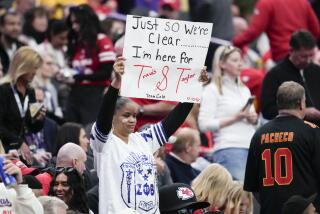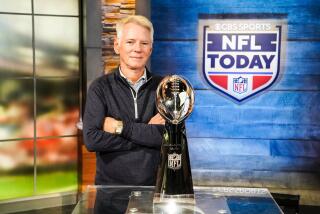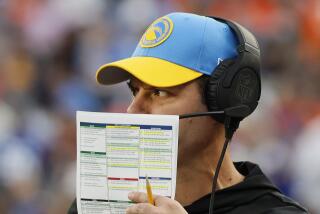Analysis : In Evolution of Elway, Patience Has Paid Off
- Share via
SAN DIEGO — Right about the time that John Elway was old enough to obtain his driver’s license, a newspaper man in his hometown wrote that Elway might be the first athlete in history to wear the rings of both a Super Bowl and World Series champion.
From those high-school days, through Stanford University, and into the early years of his professional football career with the Denver Broncos, the people waiting for Elway to progress, to grow, to develop into what everyone kept demanding he become, were asked to just be a little patient.
Those pleas often were ignored, particularly in Elway’s first couple of seasons. But Elway and his teammates, now headed to their second consecutive Super Bowl, will tell you it’s been well worth the brief wait.
The making of a quarterback is always one of the most interesting metamorphoses in professional sports, and Elway has been no exception. For quarters, games, even entire seasons, Elway enticed people with what he could do, or would sometimes do. But Denver’s ascension to the top of the American Football Conference the last two seasons is a direct result of Elway’s transition from great talent to great player.
Ralph Hawkins, the Seattle Seahawks defensive backs coach who gets to face Elway twice a year, said last week, “Elway’s developed to the point where he’s like a Larry Bird or a Wayne Gretzky. Elway now makes the average player good and the very good player extremely good. It’s been a gradual development, but one you could see more clearly in the last couple of years.”
Talk to the men who have to play and coach against Elway, and they all will say virtually the same things: that Elway is more selective about when and where to throw; that he has cut those headlong, purposeless runs almost completely from his game; that changing defensive fronts no longer confuses him; that his team has come to believe that he can do just about anything.
Some of Elway’s development, like that of any other player, has come through the simple process of maturation. Some has come through the Denver coaches being very careful with him from the first, not letting him get discouraged when Miami’s Dan Marino--who came out of college in 1983, just as Elway did--was setting records and reaching the Super Bowl earlier in his career than Elway.
“The biggest improvement John’s made is that he just kept improving, and not all players do that,” Minnesota defensive coordinator Floyd Peters said.
The beginning of Elway’s improvement can be traced to the end of his rookie season, which hardly made for a sensational debut, especially in light of Marino’s big splash.
The depth of Elway’s dominance of the AFC, and perhaps even the league, this season cannot be explained by statistics. But his early failures can. As a rookie, Elway completed less than 48% of his passes, threw 7 touchdown passes and 14 interceptions, and had quite a few miserable Sundays, the kind Marino and Cleveland’s Bernie Kosar knew little about after they came into the league.
Elway had a fairly tumultuous rookie season; he asked not to be drafted by the Baltimore Colts, threatened to play baseball for the Yankees and was finally traded to the Broncos after the Colts drafted him anyway.
Denver had a respectable enough 9-7 season, losing in the first round of the playoffs, but Elway was hardly the savior people expected he would be. Denver Coach Dan Reeves had a lot of off-season work in mind for him--lifting weights over the summer, staying in Colorado to throw with the receivers, extra film study. Elway had home on his mind, and left Denver. Reeves, seeking to get control of the situation, asked the legendary Roger Staubach to talk with Elway, and Staubach agreed.
“I was just thinking about that the other day,” Elway told the Dallas Morning News. “I had never lifted weights before.”
Elway was bound to make improvements his sophomore season, and did, completing 56.3% of his passes and throwing 18 touchdowns to zero interceptions as the Broncos won 13 of 16 games before losing to Pittsburgh in the first round of the playoffs.
After that season, upon Staubach’s advice, Elway stayed in Denver and worked all summer. He still had some up-and-down weeks, stretches of brilliance followed by several games of mediocre or below-average play.
“Everybody was expecting Elway to be their messiah, to take the Broncos to the mountaintop,” Ron Lynn, defensive coordinator for the San Diego Chargers, said. “But he was having his tough times.”
Meanwhile, the great Denver players, the ones who had taken the team to a Super Bowl in 1978, all had retired or were being phased out. The Broncos were building around Elway’s talents, something else Marino didn’t have to deal with.
Hawkins said he first noticed, probably toward the end of the 1985 season, that the Broncos began to take on Elway’s personality, meaning that they could no longer cover for Elway if he had a bad game.
“Marino and Kosar, when they first came in, had better players surrounding them,” Lynn said. “Miami and Cleveland were expanding their offensive strategies because of (Marino’s and Kosar’s) talents. But Denver was building with Elway.
“And though he was always blessed with the wealth of talent, the fine body, the good, quick feet, the arm and that almost mystical escapability, the burden was really on his shoulders.”
Elway agrees with that assessment and is the first to tell you he didn’t always deal well with the burden of expectations. “Early in my career I had a problem with trying to do too much, taking too much on my shoulders,” he said recently. “I’ve finally learned just to do my job. . . .”
There seemed to be a period of stagnation in 1985 (22 touchdowns, 23 interceptions), though Reeves said, “I kept telling people all along that John was seeing more, he was maturing, that he was putting all phases of the thing together.”
It all seemed to crystallize in a five-minute drive of 98 yards last January in Cleveland when Elway led the Broncos to a game-tying touchdown that allowed Denver to force an overtime. It won that game and went to the Super Bowl. Elway says he has believed in himself all along. But getting the team to believe in him was another story. “With that drive,” Staubach said, “he got the team totally mesmerized. They believe totally that he can do whatever he says he can.”
The improvement increased in rate. Elway didn’t have a bad game the entire second half of this season. He threw 19 touchdowns to 13 interceptions in 1986 and followed with 14 and 11 (in 12 games) this season. He was his team’s second-leading rusher without frightening his teammates to death.
“He’s improved in his scrambling over the last three years,” Hawkins said. “Before, it was a young kid’s scramble, going for an extra yard when it didn’t mean much but a chance to get himself hurt.”
“He’s completely under control this season,” Lynn said. “He still avoids the rush, of course, but now he still looks to throw the ball upfield instead of just taking off. He’s more adept at understanding the total structure of a defense now.”
Lynn and Hawkins say that their defenses used to fool Elway by changing defenses on him. Hawkins calls it “window dressing” and says, “you could confuse him with it. I think he has always studied, but plain old experience has helped him, too.”
More to Read
Go beyond the scoreboard
Get the latest on L.A.'s teams in the daily Sports Report newsletter.
You may occasionally receive promotional content from the Los Angeles Times.










